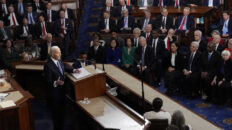It feels strange writing about this topic, some 25 years after I had it completely settled in my mind. But nothing is ever really settled, I suppose. The claim that I had long ago concluded was a basic historical and economic fallacy is back in a big way. The claim is that society needs homogeneity to be orderly and free. It is a core claim of the alt-right and its sympathizers (and, in a different way, of the alt-left). It is what leads them to reject freedom as a path forward and embrace state control of demographics.
It’s completely wrong. If you have ever been confronted with this claim, I’m writing this article for you.
Here’s the anecdote from my past. Before his death, the now-famous “social nationalist” writer and theorist, and self-proclaimed fascist, Samuel Francis and I were talking at some luncheon. I was prattling on about liberty as usual. And he interrupted me and said, paraphrasing: “Human rights and liberty are slogans we use. Much more fundamental is demographics. You have to have homogeneity for society to be orderly and operate properly. Without that, you can forget about rights and liberties.”
Was Francis Right?
Liberty is not the outgrowth of homogeneity. It is the solution to a seeming problem of heterogeneity. I said nothing because I hadn’t really thought much about that. Was this right? You don’t hear such claims in college. People who talk like this are politically incorrect, and don’t say such things in polite company. This thinking leads to forbidden thoughts, and trends toward the celebration of civic sins like racism, sexism, and xenophobia. So I had never really come to terms with it. I didn’t have to. But that also meant that I was caught off guard. I sat there a bit confused.
It took a few days but I happened upon a realization. Liberty is not the outgrowth of homogeneity. It is the solution to the seeming problem of heterogeneity. Liberty creates institutions like commercial settings, opportunities for trade and exchange, settings for mutually beneficial trade and learning. It is precisely how liberty reconciles differences among people–and creates wealth out of disagreement–that is the very source of its great magic.
Why is there not chaos? Why is there coexistence? Think back to the end of the religious wars. Enlightenment thinkers proposed that the solution to religious difference is not the burning of heretics and the imposition of an official creed. It was to allow people to believe whatever they wanted so long as they didn’t hurt others. And the system worked. How many other ways would this idea of freedom work? Gradually, it came to be rolled out to affect speech, the press, and trade. Eventually it led to broad emancipation of slaves and women. It created a new world, in which the power of the state was restrained and contained, and dismantled the old world of imposed hierarchy.
You don’t have to know history. Visit the bustling commercial district of any major American city and observe the crazy quilt of ethnicity, language, religion, race, and culture, where people are around buying, selling, and associating according to their own lights. Why is there not chaos? Why is there coexistence? Because the presence of commercial freedom allows everyone to pursue his or her own self interest in a way that also benefits others. Here is the beauty of the invisible hand at work.
The claim that liberty is preconditioned on the sameness of the population is to wish away the very problem that liberty is much adept at solving. After all, what is the problem that social order is trying to solve? It seeks to provide a setting in which people thrive as individuals even as the entire group is granted an opportunity for a better life. Differences between people are solved by freedom. This was an insight that changed the world for the better.
The trouble is that a homogeneous and isolated tribal unit managed from the top will always be poor. In fact, I realized, if you have a small tribe of that same race, language, religion, and cultural norms, the question of liberty does not have to be raised at all. Group coordination happens due to personal knowledge, verbal communication, and shared expectations of other’s similar needs, and it usually features a single leader.
The trouble is that a homogeneous and isolated tribal unit managed from the top will always be poor–mostly living hand to mouth, as small tribes in the Amazon do today–because the model doesn’t permit the expansion of the division of labor. It can work under some rarified conditions. But for the most part, life under imposed homogeneity eventually defaults to what Thomas Hobbes said of the state of nature: nasty, brutish, and short.
The Drive to Integrate
Liberty, on the other hand, rewards ever more integration of people of all kinds. It becomes profitable for everyone to do so. You are free to feel bigotry, racism, loathing of all other religious views, of different lifestyles and so. But when it comes to improving your life, you prefer dealing with the Jewish doctor than having a heart attack, grabbing lunch at the Moroccan restaurant, hiring the Mexican immigrant to tile your bathroom, listening to your favorite African-American pop band, and so on. And guess what? Gradually under these conditions, the primitive and tribalist ethos begins to subside.
This is precisely why any regime that seeks to enforce homogeneity must necessarily turn against the market and toward force. Recall that the Nazi Party had at first only encouraged peaceful boycotts of Jewish businesses, protest signs in front of stores, and so on, and laid out explicit instructions that no one be hurt. That didn’t work. The Nurenberg Laws were a desperate measure to address the “problem” that the market wouldn’t work to exclude people.
There is another insight that makes the whole claim about homogeneity a bit silly. As it turns out, no one is the same. And you know this. Think of a friend who shares the same religion, race, language, and sex, and think about your different values. There is always the possibility for conflict because no two people are alike. Your friendships survive despite this because you value your friendship more than being enemies. Expand that model to the whole of the social order and you begin to understand how and why differences lead not to conflict, disorder, and acrimony but rather to friendship, prosperity, and enlightenment.
All this talk of doing away with diversity is a shibboleth. There is no pure race, no truly orthodox religion, no one language without variation, no final unity between any two people in thought, word, or deed. No one acts or thinks as a group or collective. The social world will be, always and forever, a constellation of difference. We need the best possible social system for dealing with and making something beautiful come of it.
The New Realization
I was so pleased to work through the problem in my own mind. As with most intellectual conflict, you end up better off as a result. I came away with a greater appreciation and understanding of what liberty means for the world. Further studies reinforced my conviction that the whole purpose of liberty is to make radical heterogeneity work for everyone.
This is why I became so enraptured by the Convivencia, the 700 period before the High Middle Ages when Islam, Judaism, and Christianity coexisted to their mutual betterment (that all groups benefited from the association is not in dispute, despite the ongoing debate about just how much tolerance for difference there really was).
To understand the awesome power of heterogeneity is to adopt a different outlook on society itself. It is to embrace the core liberal claim: society doesn’t need top-down management because it contains within itself the capacity for its own management. You come to be enraptured by Frederic Bastiat’s emphasis on harmony as the means by which we live better lives.
The opponents of liberty have been barking up this tree for some 200 years. In contrast, the mental posture that homogeneity is a necessary condition leads to a series of strange obsessions over unending conflicts in society. You begin to exaggerate them in your mind. It seems like you are surrounded by a plethora of intractable wars. There is a war between blacks and whites, men and women, gays and straights, Christianity and Islam, the abled and disabled, our nation and their nation, and so on. This is the very mindset that the left and right have in common.
And guess what? If you build a large state, these conflicts do indeed appear to be more real than they are, simply because the state pits people against each other. You begin to hate that group because its members didn’t vote for your candidate, it gets more of the tax loot, it favors various forms of imposition on your liberty. Thanks to this interventionist state, you feel as if you are surrounded by enemies and lose track of the possibility for human understanding.
Freedom and Difference
Let’s return to the original claim by Mr. Francis, now widely shared and promoted by the alt-right and its sympathizers. It turns out that this is nothing new. The opponents of liberty have been barking up this tree for some 200 years, as I explain in my new book.
“You have to have homogeneity for society to be orderly and operate properly,” Francis says. This claim amounts to a rejection of liberalism itself. So let’s correct this. You have to have liberty to deal with the inescapable reality of heterogeneity. It’s the longing for sameness that leads to conflict, despotism, and impoverished human lives.














Look at milk: Before it was homogenized the cream separated and floated to the top. If you wanted a little of that luscious cream you could just dip a spoon in the top of the container and have some. If you wanted butter or ice cream or whipped cream or coffee cream or half and half you could, with some knowledge of those products, make all from the cream that was on top and some or none of the skim milk that remained below the cream. If you had no appreciation for the delicious fat in the cream, or wanted less fat in your diet, though I cannot imagine why you would, you could drink the remaining skim milk after making those other products. Homogenizing milk all but ruined it.
The final blow, that turned milk into that tasteless product on grocery shelves today, was struck by governments and their laws–state and federal–requiring milk be pasteurized to save us from contaminated milk from dirty dairies. Instead of insisting on clean, pure milk, governments required dairies to bail their milk to kill bacteria. In the process, boiling robs milk of its flavor and any healthy bacteria that would be found in pure, fresh milk.
Today the negative consequences of pasteurizing laws can be overcome by small dairies using what is called small-batch, low temperature pasteurization. It is a more-expensive, time-consuming process that doesn’t ruin the flavor. Large commercial dairies must think they cannot afford to adopt the process as long as milk consumers are willing to accept the flavorless milk they currently get away with selling. Homogenizing, however, could easily be overcome by the big guys and lower production costs by skipping it. Of course American consumers may be too lazy to shake up their milk container to mix the skim milk with the cream.
Homogeneity–humbug!
Look at milk: Before it was homogenized the cream separated and floated to the top. If you wanted a little of that luscious cream you could just dip a spoon in the top of the container and have some. If you wanted butter or ice cream or whipped cream or coffee cream or half and half you could, with some knowledge of those products, make all from the cream that was on top and some or none of the skim milk that remained below the cream. If you had no appreciation for the delicious fat in the cream, or wanted less fat in your diet, though I cannot imagine why you would, you could drink the remaining skim milk after making those other products. Homogenizing milk all but ruined it.
The final blow, that turned milk into that tasteless product on grocery shelves today, was struck by governments and their laws–state and federal–requiring milk be pasteurized to save us from contaminated milk from dirty dairies. Instead of insisting on clean, pure milk, governments required dairies to bail their milk to kill bacteria. In the process, boiling robs milk of its flavor and any healthy bacteria that would be found in pure, fresh milk.
Today the negative consequences of pasteurizing laws can be overcome by small dairies using what is called small-batch, low temperature pasteurization. It is a more-expensive, time-consuming process that doesn’t ruin the flavor. Large commercial dairies must think they cannot afford to adopt the process as long as milk consumers are willing to accept the flavorless milk they currently get away with selling. Homogenizing, however, could easily be overcome by the big guys and lower production costs by skipping it. Of course American consumers may be too lazy to shake up their milk container to mix the skim milk with the cream.
Homogeneity–humbug!
Homogeneity is a purely aesthetic concern. By including ethics and principles of justice into the mix you are essentially denying the existence of the individual and taking away his freedom of association which is at the root of all collectivist and tribalistic thinking.
The only way any sort of social order can claim to use homogeneity as a main characteristic is by using force; and as we all know this has been manifested through the State.
Homogeneity is a purely aesthetic concern. By including ethics and principles of justice into the mix you are essentially denying the existence of the individual and taking away his freedom of association which is at the root of all collectivist and tribalistic thinking.
The only way any sort of social order can claim to use homogeneity as a main characteristic is by using force; and as we all know this has been manifested through the State.
@nednetterville ha ha good points raw milk is healthy, over regulated, natural health may end up becoming black market,goodness, Homogeneity is as homosapiens specie s as archaic as Darwinian a process of selection as the annunaki and promotes forms of segregation and separates humanity from human consciousness with underlying closet forms of prejudice. I prefer to drink plant based and nut milks and avoid the cowspiracy. 🙂
@nednetterville ha ha good points raw milk is healthy, over regulated, natural health may end up becoming black market,goodness, Homogeneity is as homosapiens specie s as archaic as Darwinian a process of selection as the annunaki and promotes forms of segregation and separates humanity from human consciousness with underlying closet forms of prejudice. I prefer to drink plant based and nut milks and avoid the cowspiracy. 🙂
To me, these ads speak to the decline of popular government by displaying the majority as the yelling nonsensical horde that they seem to be. Any individual who might drink Bud Light rather than spiced mead has a place in the Pit of Misery. Also, in the event that you need something that won’t thump you out of activity the following day, there are a lot of good session lagers that can fill your needs.
cheapessaywriter
To me, these ads speak to the decline of popular government by displaying the majority as the yelling nonsensical horde that they seem to be. Any individual who might drink Bud Light rather than spiced mead has a place in the Pit of Misery. Also, in the event that you need something that won’t thump you out of activity the following day, there are a lot of good session lagers that can fill your needs.
cheapessaywriter